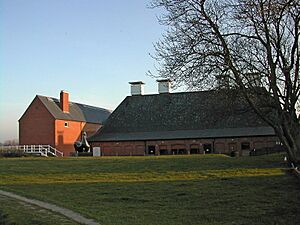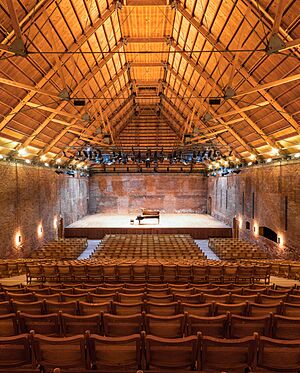Aldeburgh Festival facts for kids
The Aldeburgh Festival of Music and the Arts is a famous festival in England. It's mostly about classical music. Every June, it takes place in the town of Aldeburgh, Suffolk. The main place for the festival is the Snape Maltings Concert Hall.
Contents
The Festival's Beginning
The Aldeburgh Festival was started in 1948 by three friends: the composer Benjamin Britten, the singer Peter Pears, and the writer/producer Eric Crozier. They often traveled for their work with the English Opera Group. One day, while on tour in Switzerland, Peter Pears had an idea: "Why not create our own festival? A small festival with concerts given by friends? Why not have an Aldeburgh Festival?"
The English Opera Group planned to perform operas, but the festival quickly grew to include poetry readings, literature, plays, talks, and art shows. The very first festival happened from June 5 to 13, 1948. It used the Aldeburgh Jubilee Hall as its main stage, which was near Britten's home. Other performances took place in places like Aldeburgh's old Church of Saint Peter and Saint Paul. The first festival featured an opera called Albert Herring, Britten's new work Saint Nicolas, and performances by famous musicians like Clifford Curzon.
Growing and Moving to Snape Maltings
Over the years, the festival became bigger and used more places in nearby towns like Orford and Blythburgh. But the festival needed a larger main venue to keep growing. Then, a big old building called a maltings became available in Snape, a village close to Aldeburgh. Maltings were places where grain was prepared for making beer.
Britten, who had lived in Snape before, imagined that the largest part of the maltings could become a concert hall. They kept most of the building's original look, including its unique square roof vents. The new concert hall was officially opened by the Queen on June 2, 1967. This was at the start of the twentieth Aldeburgh Festival.
A Fire and Rebuilding
Just two years later, on the first night of the 1969 Festival, a fire sadly destroyed the concert hall. Only the outer walls were left standing. For that year, the festival quickly moved to other local venues, and only one performance was missed.
By the next year, the hall had been rebuilt! It was opened again by the Queen at the start of the 1970 Festival. The new Concert Hall at Snape Maltings became the main home for the Aldeburgh Festival, though performances still happened in the other original venues too.
Who Led the Festival?
For the first six years, Britten, Pears, and Crozier were the main artistic directors. In 1955, Britten and Pears took charge alone. The next year, Imogen Holst joined them and stayed until she passed away in 1984.
After Britten's death in 1976, many talented musicians helped lead the festival. These included Philip Ledger, Colin Graham, Steuart Bedford, Mstislav Rostropovich, Murray Perahia, Simon Rattle, and Oliver Knussen.
Music and Artists at the Festival
From the very beginning, the festival offered a wide variety of music. This included classic composers like Bach, Haydn, and Mozart. But it also featured new music, especially from young composers. By 1982, the festival had shown new works by over 75 composers, including 15 new operas that premiered there.
Concert-goers saw new music not only by Britten himself but also by composers like Lennox Berkeley, Richard Rodney Bennett, and Michael Tippett. Many of these composers even came to the festival as "composer-in-residence," meaning they stayed and worked there for a time.
Imogen Holst helped bring early choir music to the festival. Soon, music by European composers like Berg, Mahler, and Schoenberg, which were rarely heard in England at the time, became part of the performances. Later, composers like Copland and Kodály also visited the festival.
The festival wasn't just for classical music. Famous jazz artists like John Dankworth and Cleo Laine performed. Well-known actors like Joyce Grenfell and Peggy Ashcroft also made regular appearances. Even Princess Grace of Monaco came to read poetry.
The large Concert Hall allowed the festival to host full orchestras for the first time. For many years, Simon Rattle brought his City of Birmingham Symphony Orchestra to Snape. The festival also had strong connections with Russian music. Famous musicians like Rostropovich and Richter visited often. In 1970, the first performance outside the USSR of Shostakovich's 14th Symphony, which was dedicated to Britten, happened at the Concert Hall.
Peter Pears, one of the founders, performed regularly, often with Britten playing the piano. Many other famous singers and musicians performed often in the early days, including Janet Baker, Julian Bream, and Dietrich Fischer-Dieskau. Later, artists like Alfred Brendel and Ian Bostridge also became regular performers.
The Concert Hall was also great for opera. The Royal Opera performed A Midsummer Night's Dream in the first season. On June 16, 1973, Britten's last opera, Death in Venice, had its first performance at the Concert Hall, with Peter Pears in a main role. In 1976, during Britten's last festival, Janet Baker sang the premiere of his dramatic song Phaedra.
In 1979, Rostropovich led the Britten–Pears School in a performance of Eugene Onegin. In the years that followed, the school often performed an opera during the festival.
The 2020 festival had to be canceled because of the Covid-19 pandemic. Instead, a virtual festival was held online.
The Festival Today
The group that runs the Aldeburgh Festival changed its name to Aldeburgh Music in 2006.
Thomas Adès was the Artistic Director of the Festival, and then Pierre-Laurent Aimard took over from 2009 to 2016. In 2009, new spaces at Snape Maltings were opened, including the Britten Studio. This opening featured the first performance of Harrison Birtwistle's opera The Corridor.
The 2012 Festival had Oliver Knussen as the Artist in Residence. The program was very varied, as usual. It included new productions of Knussen's operas, a series of concerts exploring the music of Helmut Lachenmann, and performances by famous musicians like Menahem Pressler and Ian Bostridge. The City of Birmingham Symphony Orchestra also performed a new work by Elliott Carter. There were also special events like film screenings with live music and outdoor community events on Aldeburgh Beach.
The 100th birthday of Benjamin Britten was celebrated between November 2012 and November 2013. The 2013 Festival, which was the 66th, featured a new production of Britten's opera, Peter Grimes. It also included all of his church parables performed in Orford Church, and new works by composers like Harrison Birtwistle and Judith Weir.
The Aldeburgh Festival still has a special feeling, partly because it's in the peaceful countryside of Suffolk. It continues to focus on showing new music, new ways of performing old music, and bringing back forgotten pieces. Several of Britten's own works had their first performances here, like A Midsummer Night's Dream in 1960 and Death in Venice in 1973. Other important premieres included Harrison Birtwistle's Punch and Judy in 1968 and The Corridor in 2009.
The Aldeburgh Festival has always included visual arts, not just music. Each year, several art exhibitions are put together to go along with the music program. The main places for these exhibitions are different venues within the Snape Maltings complex and The Red House in Aldeburgh.
See also
 In Spanish: Festival de Aldeburgh para niños
In Spanish: Festival de Aldeburgh para niños



